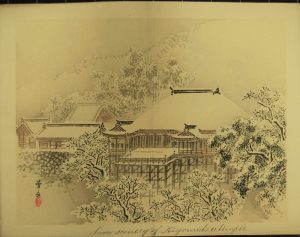Emperor Meiji and the Meiji period
On this day (30th July) in 1912, Emperor Meiji of Japan died. Born in 1852, he began his reign in 1867, the 122nd Emperor of Japan according to the traditional order of succession. Meiji presided over a period of rapid change for the nation of Japan, overseeing its rise from feudal state to industrial power. Much has been written about this period, to which I am not qualified to add, so this blog post will look at the Meiji period through the lens of some of our artworks. However, for those who have access to the Journal of the Royal Asiatic Society, there are several articles related to this period that have been published throughout the Journal’s history and which can be read on the Cambridge University Press website.
Within our collections we have five sets of Japanese artworks:
- Head cat. no. 076 consists of 10 prints c.1780-1900 (therefore some falling within the Meiji period) of Japanese people and scenes, three of these are colour, the remaining black-and-white.
- Head cat. no. 077 is an album of 200 prints mostly of theatrical scenes and includes many in the form of diptychs and triptychs. This was donated by Herbert Charles Fanshawe in December 1923. Many of these images can be found on our Digital Library.
- Head cat. no. 078 is a small album of 160 brush drawings, copies of the illustrations in batsu-zō dzui which was presented by Henry Faulds in 1922.
- Head cat. no. 079 is an album in concertina form of 50 drawings and sketches by Kanda Sōtei. This was also presented by Henry Faulds.
- Head cat. no. 80 is entitled Morikawa Sðbun: Miyako meisho ni-jū-go kei and consists of twenty-five views of famous places in Kyoto. These were printed in colour with captions in cursive Roman script by the publisher, Tanaka Jihei. This album was also donated by Herbert Charles Fanshawe.
It is the last album that I will feature today as it was published in 1895 – right in the middle of the Meiji period – but if you would like information about any of the other collections, please do not hesitate to contact the Society. The pictures are very delicately drawn and make up a concertina booklet of approximately 24 x 15 cm so when the book is unfolded each image is about 27 x 21 cm with the caption underneath. I just hope that the images below can do justice to the actually book’s images.





If you want to read more about Herbert Charles Fanshawe and see images of cherry blossom rather than plum, please follow this link to a previous blog post by our Director, Alison Ohta.
With regard to other Society news, we are pleased to say that we have been able to welcome researchers back into our Reading Room. It is good to know that we can provide a suitable service in these difficult times and that researchers are beginning to make use of the times that we are open. For full details as to how to access our Collections please read our current guidelines.
